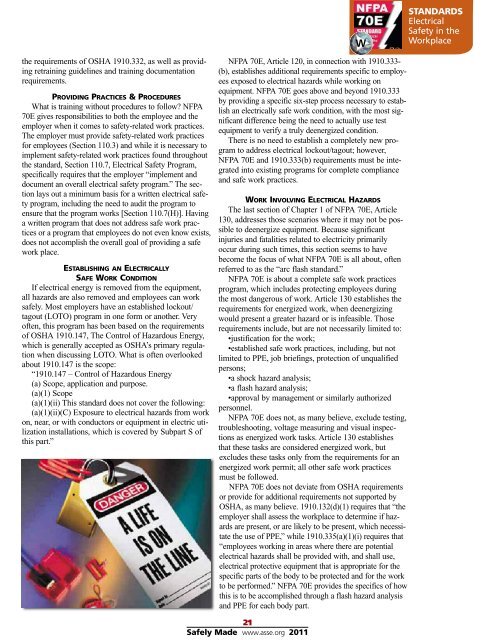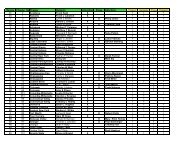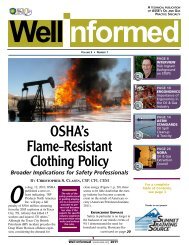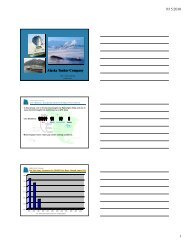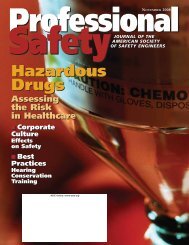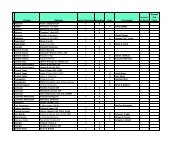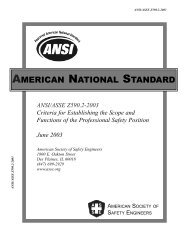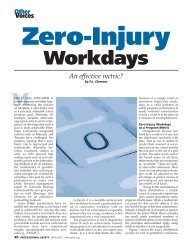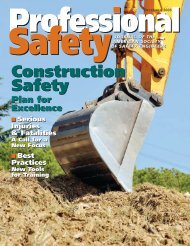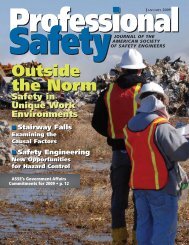Safety & Health Effects of Shift Work - ASSE Members
Safety & Health Effects of Shift Work - ASSE Members
Safety & Health Effects of Shift Work - ASSE Members
You also want an ePaper? Increase the reach of your titles
YUMPU automatically turns print PDFs into web optimized ePapers that Google loves.
W<br />
STANDARDS<br />
Electrical<br />
<strong>Safety</strong> in the<br />
<strong>Work</strong>place<br />
the requirements <strong>of</strong> OSHA 1910.332, as well as providing<br />
retraining guidelines and training documentation<br />
requirements.<br />
PROVIDING PRACTICES & PROCEDURES<br />
What is training without procedures to follow NFPA<br />
70E gives responsibilities to both the employee and the<br />
employer when it comes to safety-related work practices.<br />
The employer must provide safety-related work practices<br />
for employees (Section 110.3) and while it is necessary to<br />
implement safety-related work practices found throughout<br />
the standard, Section 110.7, Electrical <strong>Safety</strong> Program,<br />
specifically requires that the employer “implement and<br />
document an overall electrical safety program.” The section<br />
lays out a minimum basis for a written electrical safety<br />
program, including the need to audit the program to<br />
ensure that the program works [Section 110.7(H)]. Having<br />
a written program that does not address safe work practices<br />
or a program that employees do not even know exists,<br />
does not accomplish the overall goal <strong>of</strong> providing a safe<br />
work place.<br />
ESTABLISHING AN ELECTRICALLY<br />
SAFE WORK CONDITION<br />
If electrical energy is removed from the equipment,<br />
all hazards are also removed and employees can work<br />
safely. Most employers have an established lockout/<br />
tagout (LOTO) program in one form or another. Very<br />
<strong>of</strong>ten, this program has been based on the requirements<br />
<strong>of</strong> OSHA 1910.147, The Control <strong>of</strong> Hazardous Energy,<br />
which is generally accepted as OSHA’s primary regulation<br />
when discussing LOTO. What is <strong>of</strong>ten overlooked<br />
about 1910.147 is the scope:<br />
“1910.147 – Control <strong>of</strong> Hazardous Energy<br />
(a) Scope, application and purpose.<br />
(a)(1) Scope<br />
(a)(1)(ii) This standard does not cover the following:<br />
(a)(1)(ii)(C) Exposure to electrical hazards from work<br />
on, near, or with conductors or equipment in electric utilization<br />
installations, which is covered by Subpart S <strong>of</strong><br />
this part.”<br />
NFPA 70E, Article 120, in connection with 1910.333-<br />
(b), establishes additional requirements specific to employees<br />
exposed to electrical hazards while working on<br />
equipment. NFPA 70E goes above and beyond 1910.333<br />
by providing a specific six-step process necessary to establish<br />
an electrically safe work condition, with the most significant<br />
difference being the need to actually use test<br />
equipment to verify a truly deenergized condition.<br />
There is no need to establish a completely new program<br />
to address electrical lockout/tagout; however,<br />
NFPA 70E and 1910.333(b) requirements must be integrated<br />
into existing programs for complete compliance<br />
and safe work practices.<br />
WORK INVOLVING ELECTRICAL HAZARDS<br />
The last section <strong>of</strong> Chapter 1 <strong>of</strong> NFPA 70E, Article<br />
130, addresses those scenarios where it may not be possible<br />
to deenergize equipment. Because significant<br />
injuries and fatalities related to electricity primarily<br />
occur during such times, this section seems to have<br />
become the focus <strong>of</strong> what NFPA 70E is all about, <strong>of</strong>ten<br />
referred to as the “arc flash standard.”<br />
NFPA 70E is about a complete safe work practices<br />
program, which includes protecting employees during<br />
the most dangerous <strong>of</strong> work. Article 130 establishes the<br />
requirements for energized work, when deenergizing<br />
would present a greater hazard or is infeasible. Those<br />
requirements include, but are not necessarily limited to:<br />
•justification for the work;<br />
•established safe work practices, including, but not<br />
limited to PPE, job briefings, protection <strong>of</strong> unqualified<br />
persons;<br />
•a shock hazard analysis;<br />
•a flash hazard analysis;<br />
•approval by management or similarly authorized<br />
personnel.<br />
NFPA 70E does not, as many believe, exclude testing,<br />
troubleshooting, voltage measuring and visual inspections<br />
as energized work tasks. Article 130 establishes<br />
that these tasks are considered energized work, but<br />
excludes these tasks only from the requirements for an<br />
energized work permit; all other safe work practices<br />
must be followed.<br />
NFPA 70E does not deviate from OSHA requirements<br />
or provide for additional requirements not supported by<br />
OSHA, as many believe. 1910.132(d)(1) requires that “the<br />
employer shall assess the workplace to determine if hazards<br />
are present, or are likely to be present, which necessitate<br />
the use <strong>of</strong> PPE,” while 1910.335(a)(1)(i) requires that<br />
“employees working in areas where there are potential<br />
electrical hazards shall be provided with, and shall use,<br />
electrical protective equipment that is appropriate for the<br />
specific parts <strong>of</strong> the body to be protected and for the work<br />
to be performed.” NFPA 70E provides the specifics <strong>of</strong> how<br />
this is to be accomplished through a flash hazard analysis<br />
and PPE for each body part.<br />
21<br />
Safely Made www.asse.org 2011


